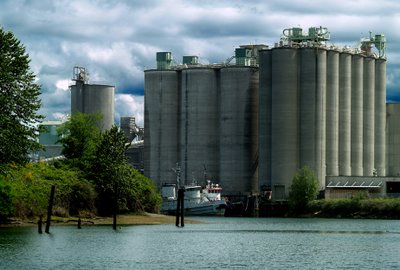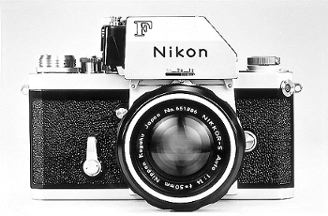
Tied Up on the Duwamish
Shameless photoshop manipulation on this one. Looks ok at low magnification but the artifacts look pretty bad at 50% or higher. The dramatic sky was in the original image, not imported from somewhere else but I had to created a separate sky layer and use levels to set the black and white reference points as well as moving the middle gray up toward the high end to increase the contrast. This is all standard photoshop stuff for dramatic skies and in my humble opinion the result is a visual cliche.
To get the contrast looking good on main subject I ended up sacrificing the front end of the inside tug boat which was almost black. The resulting image is a little confusing, looks like a tug boat with two cabins. Look at the previous photo Tied Up at the Silos and you will see the front end of the second tug. I "fixed" the problem with another layer for the front end of the inside tug. See below. You will need to click it to enlarge the image to see the difference.

Working with the Olympus E-500, I do not shoot with the preset Olympus "vivid light" turned on, I set it to "normal". I set the ev compensation to -.7 assuming that I am using the TTL metering. I also carry an ancient Gossen Multi-beam which allows me take incident readings. Lately I have been leaving the exposure mode dial set to manual and controlling the bracketing with the exposure dial. This works for subjects that are not moving.
I prefer to shoot slightly soft negatives. This is a hang over from my early B&W work. In high contrast lighting I would shoot Tri-X exposed at 320-400ASA with half stop bracketing and develop in D76 68f 6 1/2 to 7 minutes which produced a slightly soft negative. If there was significant material in zone two then a third stop over (ASA 320) would help preserve it while under development would compress the highlights. The advantage of using Tri-X or Ilford HP4 was the long toe on the density curve. This translated into zone two shadows with detail that you could see if you didn't push your highlights too far up with long development times.
A soft digital negative (Olympus calls it "normal") is just a little bit flat which insures that your highlights will not block up and your zone two shadows will not be lost. A negative like this will nearly always require a levels adjustment but it is far better to do this later than to try and get your digital camera to do it right the first time and risk bringing home an image you cannot fix.
